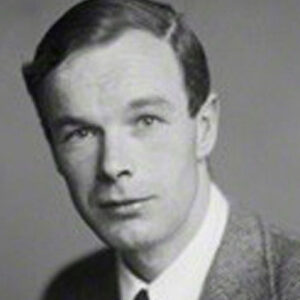Sir Alan Lloyd Hodgkin was an English biophysicist and physiologist who, along with Sir John Eccles and Andrew Fielding Huxley, was awarded the Nobel Prize in Physiology or Medicine for discovering the chemical processes that controlled the transmission of electrical impulses from one nerve cell in the brain to another via nerve fibers. Incorporating microelectrodes into the enormous nerve fibers of a squid, he and his colleagues demonstrated that the electrical potential of a nerve fiber conveying an impulse is greater than that of a nerve fiber at rest. This revelation contradicted the previous theory that neuron membranes disintegrate when an impulse is transferred. This notion developed by Hodgkin and Huxley is referred to as the “voltage clamp.” They discovered that potassium ions are highly concentrated within nerve fibers, while sodium ions are highly concentrated in the surrounding fluid. Experiments demonstrated that while nerve fibers are at rest, only potassium ions are permitted to flow through the membrane, whereas sodium ions are granted passage when the fibers are stimulated. His discovery of the continuous series of depolarization of nerve cell membranes is known as the “Hodgkin Cycle.”
Youth and Early Life
Alan Lloyd Hodgkin was born on February 5, 1914, in Banbury, Oxfordshire, England parents to George Hodgkin and Mary Wilson.
His mother remarried Lionel Smith after his father died of illness in 1918 in Baghdad. They continued to reside with him thereafter.
From 1923 to 1927, he attended The Downs School, Malvern, and from 1927 to 1932, he attended Gresham’s School, Holt.
In 1932, he enrolled in the Cambridge University-affiliated Trinity College and remained there until 1936.
Alan Lloyd’s Career
Alan Lloyd Hodgkin began his research on the neural systems of frogs in 1935 while attending Cambridge University.
In 1937, Gasser invited him to work in his laboratory located at the Rockefeller Institute in New York.
From 1937 to 1938, he learned to dissect squid axons at ‘Woods Hole’ with the assistance of K. S. Cole.
In 1938, he returned to Cambridge and began working with one of his former students, A.F. Huxley.
From 1939 to 1940, he worked for the British Air Ministry at Farnborough on aviation medicine with Matthews.
From 1940 through 1945, he conducted numerous experiments to improve the radar, which greatly aided the war effort. He worked on 10-centimeter display and scanning devices to enhance aircraft’s night-fighting capability. Additionally, he contributed to the creation of the “Village Inn AGLT Airborne Gun-laying System.”
Early in 1941, he participated in the in-flight testing of the centimetric radar onboard a Bristol Blenheim aircraft.
In 1945, he joined the ‘Cambridge University faculty as an instructor in the Physiology Laboratory.
A few months later, upon Huxley’s return to Cambridge, he reunited with Huxley to continue their earlier studies.
The majority of Hodgkin and Huxley’s investigations on the chemical and electrical properties of nerve fibers were conducted in the laboratory of the “Marine Biological Association” until 1952.
Hodgkin was appointed a ‘Foulerton Research Professor’ at the ‘Royal Society’ in 1951.
In 1952, Hodgkin and Huxley were able to publish a paper summarizing the results of their studies on nerve fibers, despite the fact that the war had delayed their work for a period of time after 1939.
From 1958 to 1960, Hodgkin was a member of the ‘Royal Society Council,’ and from 1959 to 1963, he was a member of the ‘Medical Research Council.’
From 1961 to 1967, he served as the Physiological Society’s foreign secretary.
In 1966, he was elected president of the Marine Biological Association, and in December 1970, he was elected president of the Royal Society.
In 1970, he became a ‘John Humphrey Plummer Professor of Biophysics’ at ‘Cambridge University and served as a professor of biophysics.
In 1971, he was appointed chancellor of ‘Leicester University,’ a position he held until 1984.
He was named Master of Trinity College in 1978 and remained in that position until 1985.
During various periods of his service, he became a ‘Foreign Member of the American Philosophical Society,’ a ‘Foreign Member of the American Academy of Arts and Sciences,’ a ‘Member of the Deutsche Akademie,’ a ‘Honorary Fellow of the ‘Indian National Science Academy,’ an Honorary M.D. of the universities of Louvain and Berne, and an Honorary D.Sc. from the universities of Newcastle, Sheffield
His Notable Works
1964’s “Conduction of the Nervous Impulse” was published as one of Sir Alan Hodgkin’s works.
1992 saw the publication of his autobiography, Chance and Design: Reminiscences of Science in Peace and War.
Honors & Accomplishments
In 1958, Sir Alan Lloyd Hodgkin received the “Royal Medal of the Royal Society.”
In 1963, he was awarded the Nobel Prize in Physiology or Medicine.
In 1964, he became a member of the Royal Danish Academy of Sciences.
In 1965, he was awarded the “Copley Medal of the Royal Society.”
In 1972, he has proclaimed a “Knight of the British Empire” and awarded his knighthood.
In 1973, he was also given the “Order of Merit.”
Personal History and Legacy
In 1944, he wed Marion Rous, daughter of the renowned pathologist Peyton Rous, whom he met at the Rockefeller Institute.
After Sarah and Deborah, he had a son, Jonathan, and then Rachel, his youngest daughter from this marriage.
Sir Alan Lloyd Hodgkin passed away on December 20, 1998, in Cambridge, England.
Estimated Net worth
Unknown.
Trivia
Sir Alan Lloyd Hodgkin’s favorite interests included traveling and fishing.


